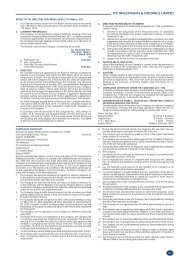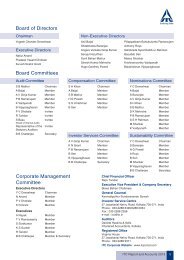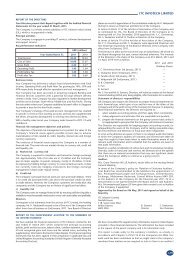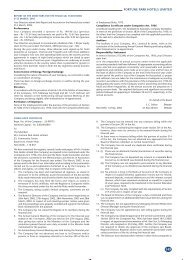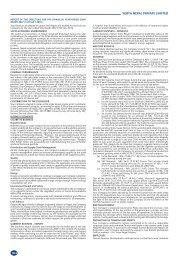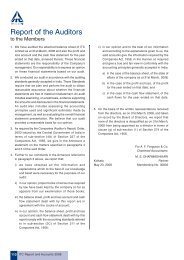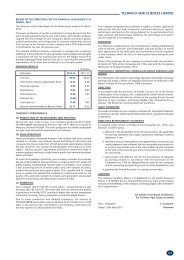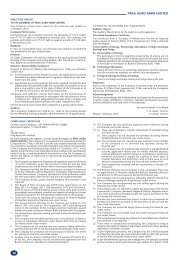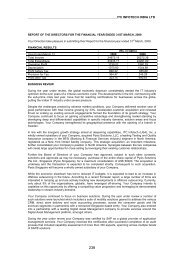SUBSIDIARY COMPANIES - ITC Ltd
SUBSIDIARY COMPANIES - ITC Ltd
SUBSIDIARY COMPANIES - ITC Ltd
You also want an ePaper? Increase the reach of your titles
YUMPU automatically turns print PDFs into web optimized ePapers that Google loves.
NOTES TO FINANCIAL STATEMENTS<br />
1. Brief information on the Company<br />
Technico Horticultural (Kunming) Co., <strong>Ltd</strong>. (the “company”) was<br />
established as a wholly foreign-owned enterprise invested by Technico<br />
Asia Holdings Pty Limited., under the “laws of the People’s Republic<br />
of China (the “PRC”) on Enterprises Operated Exclusively with Foreign<br />
Capital” and through the approval by the Foreign Economic and Trade<br />
Department of Yunnan province in the certification Dian zi (1997)<br />
No.0049. The Company of the registered capital USD2,300,000.00<br />
was registered, with the business license number of Qi Du Zong zi<br />
No.000716, on 8 December 1997. The tenure of the Company is 50<br />
years and may be extended upon application by the board of directors<br />
and approval of the relevant government authorities. The principal<br />
activities of the Company are the development, production and supply<br />
of microtuber potato.<br />
2. Significant accounting policies and accounting estimates<br />
(1) Accounting regulations<br />
The Company implements “The Accounting Standards for<br />
Enterprises” and “The Accounting Regulations of Enterprises” and<br />
the supplementary stipulate.<br />
(2) Fiscal year<br />
The fiscal year for the Company is from 1 January to 31 December<br />
of each calendar year.<br />
(3) Accounting currency<br />
The Company’s financial records are maintained and the financial<br />
statements are stated in Renminbi (”RMB”).<br />
(4) Accounting basis and principle<br />
The accounting basis of The Company is accrual principle, and the<br />
accounting principle is historical cost principle.<br />
(5) Foreign currency transactions<br />
All foreign currency transactions have been translated into RMB<br />
at the market rates of exchange prevailing on the dates of<br />
transactions. Monetary assets and liabilities denominated in foreign<br />
currencies at the balance sheet date are translated into RMB at the<br />
market rates of exchange ruling at that date. The resulting exchange<br />
gains or losses are capitalized if they have relation to acquiring<br />
fixed assets before the fixed assets intended-use have been<br />
commenced; or are accounted as long-term prepaid expense AIin<br />
the preparative duration, or are dealt with in the profit and loss<br />
account in the operating duration, if they have not relation to<br />
acquiring fixed assets.<br />
(6) Cash equivalents<br />
Cash equivalents are the short-term investments, which are held<br />
by the Company at the short-term (generally within 3 months<br />
from the purchasing date to the date due), are easy in currency<br />
and conversion to known-account cashes, are of little value<br />
fluctuations.<br />
(7) Allowances for uncollectible accounts<br />
The Company uses the allowance method in which the allowances<br />
for uncollectible accounts for the receivable items (including the<br />
accounts receivable and other receivable) are recognized in the<br />
aging receivable account method and are dealt with in the profit<br />
and loss account at the balance sheet. The aging receivable account<br />
method is made as follows:<br />
a. Within 1 year, at 0.5 percent on the amount of the part;<br />
b. 1-2 year, at 10 percent on the amount of the part;<br />
c. 2-3 year, at 30 percent on the amount of the part.<br />
If any receivable is evidently different from the others, the specific<br />
identification method is made for the receivable item.<br />
(8) Inventories<br />
Inventories, which are recorded at actual cost, include finished<br />
goods, work-in-progress and raw material.<br />
For the unrecoverable inventory cost due to the damage, partly<br />
or wholly obsolescence, or market price lower than the cost, the<br />
provision for decline in value of inventories is determined according<br />
to the difference of the actual cost lower than net realizable value<br />
on an item-by-item basis, at the end of the period.<br />
(9) Fixed assets and depreciation<br />
Fixed assets are recorded based on the actual cost. At the inception<br />
of a lease, the fixed assets by a lessee under a finance lease are<br />
recorded at an amount equal to the lower of the carrying amount<br />
of the leased asset originally recorded in the books of the lessor<br />
and the present value of the minimum lease payments. (If the<br />
proportion of the recorded amount of the leased assets to the total<br />
amount of assets is lower than 30 percent, the leased assets are<br />
recorded at an amount equal to the total minimum lease payments.)<br />
92<br />
TECHNICO HORTICULTURAL (KUNMING) CO. LIMITED<br />
The standard about fixed asset: House and building, machinery<br />
and equipment, Motor vehicle and so on of the useful life more<br />
than one year, and non-principle operating equipment of the unit<br />
value over 2000 yuan and the useful life more than two years<br />
Depreciation is calculated on the straight-line basis to write off the<br />
cost of each asset over its estimated useful life after deducting the<br />
estimated residual value. The categories, useful life and residual<br />
value, annual depreciation rate are as follows:<br />
Category Estimated Annual Residual<br />
useful life depreciation<br />
rate<br />
value<br />
House and building 20 years 4.50% 10.00%<br />
Production equipment 10 years 9.00% 10.00%<br />
Motor vehicle 5 years 18.00% 10.00%<br />
Office equipment and other 5 years 18.00% 10.00%<br />
Provision for impairment: At the end of each period, The Company<br />
examines its fixed assets and if market value of the fixed asset has<br />
declined continually, become obsolete in technology, been not<br />
in use in the long term, or been damage, and the recoverable<br />
amount of the fixed asset is less than its carrying amount, the<br />
provision for impairment is determined according to the difference<br />
of the recoverable amount of the fixed asset lower than its carrying<br />
amount on an item-by-item basis.<br />
(10) Intangible assets<br />
An intangible asset, which is acquired separately, is recorded based<br />
on the actual purchase price paid.<br />
The cost of an intangible asset is amortized evenly over its expected<br />
useful life starting in the month in which it is obtained.<br />
If the expected useful life exceeds the beneficial period stipulated<br />
in the relevant contract or the effective period stipulated by law,<br />
the amortization period of an intangible asset is determined in<br />
accordance with the following rules:<br />
a. If the relevant contract stipulates the beneficial period but the<br />
law does not stipulate the effective period, the amortization<br />
period is not longer than the beneficial stipulated by the<br />
relevant contract;<br />
b. If the relevant contract does not stipulate the beneficial period<br />
but the law stipulates the effective period, the amortization<br />
period is not longer than the effective period stipulated by<br />
law;<br />
c. If the relevant contract stipulates the beneficial period but the<br />
law also stipulate the effective period, the amortization period<br />
is not longer than the shorter of the beneficial period and the<br />
effective period.<br />
If the relevant contract does not stipulate the beneficial period and<br />
the law does not stipulate the effective period, the amortization<br />
period does not exceed 10 years.<br />
If an intangible asset is no longer expected to be able to generate<br />
any economic benefits that flow to the enterprise, the carrying<br />
amount of the intangible asset is written off and is recognized as<br />
gain or loss the current period.<br />
The Company reviews the carrying amount of the intangible asset<br />
at the end of each period. The difference of the expected receivable<br />
amount lower than the carrying amount of the intangible asset is<br />
recognized as provision for impairment on an item-by-item basis.<br />
(11) Long-term prepaid expense<br />
Long-term prepaid expenses are recorded based on the actual<br />
payments and amortized on the straight-line basis in the beneficial<br />
period.<br />
The expenses (except for acquiring fixed assets), which occur in<br />
the preparative duration, are recorded as long-term expense, and<br />
are amortized in the month starting the operating<br />
(12) Principle for recognition of revenue<br />
a. Revenue from the sale of goods<br />
The revenue is recognized when all the following conditions<br />
have been satisfied: the Company has transferred to the buyer<br />
the significant risks and rewards of ownership of the goods;<br />
the enterprise retains neither continuing managerial involvement<br />
to the degree usually associated with ownership nor effective<br />
control over the goods sold; it is probable that the economic<br />
benefits will flow to the Company; the relevant amount of<br />
revenue and costs can be measured reliably.




